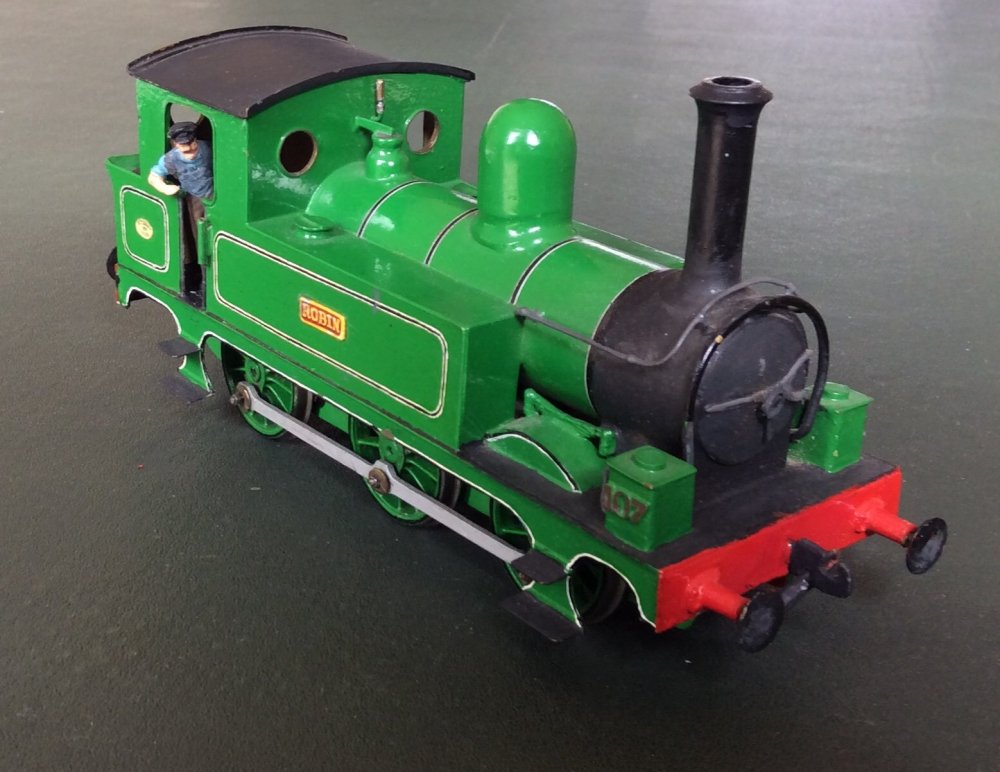-
Posts
323 -
Joined
-
Last visited
-
Days Won
2
Content Type
Profiles
Forums
Events
Gallery
Blogs
Store
Community Map
Everything posted by Northroader
-
As you asked, David, a bit more on springing the leading axle on a 2-4-0. First a close up picture of Sylph: I'm pushing the wheel up in the oval guiding slot, and acting against the pressure of a rectangle of brass foil screwed under a frame spacer. The foil is quite thin, I’d guess under .010” thick. It came from a pack of different strips coiled up in a tin can, labelled “brass shimstock”. I’m afraid I bought it a long time back from an ironmongers before DIY stores were invented. The brass does retain sufficient springiness to give some downward pressure, and acts against the wheelset tilting, but... how do I do it now? A similar wheelset on another more recent build. Here there’s a strip of brass screwed across a frame stretcher, and at each end there’s a finger pressing down on the axle. The fingers are 28swg phosphor bronze wire. Phosphor bronze does keep the springy quality better than brass, and having them placed at each end of the axle counteracts the tilting better. (The loops underneath are sprung pickups on the driving wheel in 22swg p.b.) Slaters used to supply both sizes in a small pack, but looking at their website tonight, it’s no longer available from there, I’m afraid. whilst I'm on, here’s a close up between the drivers showing another key item on a 2-4-0. You’ll see the gear and motor are tipped up as far forward as I can get them inside the firebox. The space behind the motor to the backhead is then as full as lead sheet as I can manage, and just in front of the trailing driver axle you’ll see a nice big brass block tailored to fit between the frames. This all moves the mass of the loco back over the drivers, as it’s easy to get a loco noseheavy.
-
Thanks for your comments, having made the model I’m aware there are shortcomings in things like accuracy, squareness and so on. It was early on in my model building, but I wouldn’t like to say I’ve got much better since, Keep on trying. I'm away from base at present, and will try and show how the leading axle is sprung when I get back home.
-
Having done two locos which were formed from kits for the running chassis, I felt I had learned enough to try and make my own. The key investment was buying my only machine tool, a pillar drill from Ferm. It has a nice flat table, and you can put your work down on this, hold it steady with one hand, and bring the drill down with the other, knowing it’s dead square to the work. The drill was well made, reasonable value, and has been used many times since for loads of work. The one job that I bought in was a set of coupling rods of the right wheelbase, which were steel etchings which folded up like a concertina to make a lamination. They were soldered up solid using Bakers soldering fluid, an acid flux. The hole centres were transferred over to a pair of frames, filed up to profile from brass strip sweated together. Axle holes were drilled and opened out to take bushes, holes for the bought in frame spacers were drilled and countersunk, then I put in a wheel on an axle which showed me where to place holes for pickups to go behind the flanges. The frames could then be unsweated, cleaned up, and assembled. I’d also bought a 3/16” reamer, so I could pass this through the axle holes and make sure the wheels turned freely. The coupling rods needed the holes opening slightly before everything moved freely, but at the end of it I’d got a working chassis. The loco I’d chosen was another MGWR type, the K class 2-4-0, which became the GSR/CIE G2, mine having had a 65 year life all told. The superstructure was formed from brass sheet, and the whole job was done just like the L 0-6-0. So then I came to put it down on the rails and juice up. Problem! The wheels turned, but were spinning, with the loco just inching forwards very slowly. I’d made it with all the axlebushes mounted rigidly in the frames, and the wheels all touching down. Actually they never do all touch down, there’s always going to be a few thousandths of an inch difference, and in my case the leading carrying wheels were taking too much of the weight and lifting the centre drivers just clear of the track. Once I’d worked that out, I removed the leading axle bushes and put some thin side frame extensions in brass sheet, with a vertical slot to guide the axle, and a piece of springy brass acting down on the lead axle to keep the wheels on the rails. Then make sure the main weight of the loco was placed between the drivers, and try again. Success! I’ve now got a decent runner that will pull a couple of coaches. Its No. 23 “Sylph” (named after the missus, of course)
- 149 replies
-
- 16
-

-

-
Notice you say regional trains, a bit ago I bought a ticket, asking from A to B. The ticket office bloke gave me a ticket, and a very lengthy spiel, which went in one ear and out the other, as I dont speak German. Looking at it, no mention of the stations, anyhow did the journey, and come back from a different place, an unstaffed station. Tried to get a new ticket from the guard, and it turned out I’d been given a regional runround for the area as the cheapest option. Changed trains to get back to A, and caught an intercity, and got a frightful roasting off the ticket collector, using a regional ticket on an intercity. Luckily the next stop was the one I wanted. So just maybe this new ticket has the same drawbacks?
-
Just from the unused recesses of my brane, so not at all reliable, I think it was A flat / G flat. (Edit: I’m not at all musical, it was just what it said on the stores shelf)
- 1 reply
-
- 1
-
-
Linking in Sharps singles and Continental modelling, there was a Dutch artist called Anton Pieck, who had a very enjoyable dated “folksy” style, with plenty going on, in nice architectural settings, and very good for a “cameo” setting, complete with a level crossing and keeper. Funnily enough none of the old Dutch railways had one of the early Sharps as shown here:
-
I do mine using cooking foil. Some threads are glued on the back with evostik for the tying down, and I fold the edges over to give a clean edge and add some strength. Then paint with Humbrol light grey primer, topped with Matt dark grey. The lettering is Matt white applied with a springbow pen, but you need to be careful or the pen will cut through the foil. It’s quite good for taking up natural looking sags and folds.
-
Brookhall Mill - A GNR(I) Micro Layout
Northroader replied to Patrick Davey's topic in Irish Model Layouts
-
Going back to your opening post, for a microlayout in Irish narrow gauge, could I suggest Moyasta Junction as it currently exists operated by a preservation society, which is as basic as it gets. Here’s a sketch of the layout, and I’d suggest that the engine shed and siding which was added by the new folks, is replaced to opposite the signal cabin, making a handier operating situation. heres a link to Roger Farnworths article on the West Clare with good pictures past and present. https://rogerfarnworth.com/2019/05/09/the-west-clare-railway-part-6-moyasta-to-kilkee/
-

Layout Idea: GNR(I) Bundoran-Sligo line
Northroader replied to RaglanRoad's topic in Irish Model Layouts
You did get the MGWR and the GNRI meeting at Cavan otherwise. -

MGWR Passenger and Goods Stock - is there a need?
Northroader replied to 2996 Victor's topic in Irish Models
I’ve just had the one kit from Shapeways, a GER coach which came around a year ago. I gather it was an improved print, with a whitish dusty finish, and I was quite pleased with it. Maybe earlier productions weren’t as good, the first time I saw a 3D print it reminded me of a 50ply sweeping off the pavement. Resin castings? I’ve tried them, but the problem with me is having a flexible mould to free them always led to some distortion. There must be ways of getting round this, as when I buy them commercially, they’re nice and square. -

MGWR Passenger and Goods Stock - is there a need?
Northroader replied to 2996 Victor's topic in Irish Models
On the coaching stock side, you could have a look at the 3D prints on Shapeways/Recreation 21 site. -
The second loco I fancied was the MGWR “L” 0-6-0 standard goods, which does have a varied history, with alphabetical suffixes for variations, and becoming two classes in GSR days. I hadn’t built up enough competency to build it entirely by myself, I needed a machined chassis, and as luck would have it, the wheel sizes and wheelbase are very close to a GWR 2251 class, just the Swindon loco has more overhang at the back end. At the time, there was a long established firm, CCW, doing kits for chassis and bodies of quite a wide range of popular prototypes. The chassis were very similar to the Leinster Models kits, with 1/16” frame plates and spacers, axle bushes, and the coupling rods were very nice milled to profile in nickel silver. They were reasonably priced, so I sent for it, and some Slaters wheels, buffers, pickups, and a motor/gearbox from Premier. Then it was just trim a foot or so of the back end and reposition the rear spacer holes, and mark and drill for the pickups. Everything fitted very nicely, and I became a CCW fan. They had a great catalogue, with an extensive range of products, a good stand at the Gauge 0 Guild meetings, and I started to pick out what I fancied next. Then they stopped trading! Just like that, there one minute, gone the next. On to the body, I did this myself from .018” brass sheet, tinsnips, hacksaw and filing. Anybody remember Micromodels? They were neat little printed card sheets in a pack, very small scale, and I used to cut them out and stick them together when I was a kid, and they did have the virtue of showing how you could form the shape of a loco from a flat sheet, so useful training. You can still pick them up on eBay, and there are folks still producing the same idea as downloads. Here’s a sample if you haven’t come across them. http://worldofmicromodels.nl/wp-content/uploads/2019/10/Set-NS-V-Justin-Olson.pdf Using this principle, plus some commercial castings for a dome, the superstructure was formed. The tender is made with the outside frames as dummies hanging down from the body, and the wheelsets run in a detachable inside frame. You’ll see it has a PCB fixed on carrying phosphor bronze whiskers (wire from Slaters) acting on the wheel flanges for pickups Then the body gets done from brass sheet in a similar manner to the loco. And there you have it, I really did fancy the unique look for the MGWR “flyaway”cab.
- 149 replies
-
- 14
-

-

-
-
I think when you’ve got a small layout, the water tank/signalbox situation is either/or, both together is going emphasise a cramped look. The same thing happened on my line.
-

Ernies Massive Irish 1930's to 2005 Photo Archive
Northroader replied to Glenderg's topic in Photos & Videos of the Prototype
I’m surprised reading the article that there’s little mention of the historic and picturesque nature of the place as a tourist attraction? -
I fancy the Guvvinment put the money up and the MGWR were very helpful in spending it, contrast the “tin sheds” on the GSWR with the tasteful brick builds on the MGWR.
- 309 replies
-
- 2
-

-

-
- mgwr
- 21mm gauge
-
(and 1 more)
Tagged with:
-

Ernies Massive Irish 1930's to 2005 Photo Archive
Northroader replied to Glenderg's topic in Photos & Videos of the Prototype
The BR container is loaded crosswise instead of lengthwise. Maybe there’s two on the open? -
https://www.steamtrainsireland.com/rpsi-collection/52/504-guinness-grain-van I fancy these wouldn’t stray off the GNR, ( mind, they’d have to get to the brewery over the GSWR ) but it’s an interesting prototype.
-
So, early on in ‘96, once the Christmas expenses were out of the way, I sent off to Dublin for an 0 gauge kit of the one Irish loco the McGowans did. They called it a “Bat”, I couldn’t say why, as that wasn’t the first named in the class, otherwise known as a MGWR “E”, or a GSR/CIE “J26” 0-6-0T. it was the first loco I tried building, and the way it was done has coloured my approach ever since. The chassis was simplicity itself, two 1/16” brass strips for the main frames, four machined brass spacers to set it up, a set of brass axle bushes, and two plain steel strips with the pilot holes drilled in for the coupling rods. You'll see there is no compensation, and I’m of a mind that if you get all the tips of the wheel flanges touching down on a glass plate with no rocking, compensation is an extra complication. The bit of extra depth in finescale wheel flanges should be adequate enough to cover track irregularities, if the loco keeps derailing, look at your track. I added some L shaped brass strips fore and aft to give a place for the screws to attach the superstructure, but you can find spacers with a central vertical hole drilled through. The Mashima motor and gears ride on the back axle, and I made a strap to go round the motor and screw on to a spacer to support the motor. Since I built this loco my fitting skills have improved, the crankpin holes had to be drilled out oversize before it would give me free running with the coupling rods on, and larger washers were needed. The rods, of course, needed a lot of filing to go from a plain steel bar to a decent profile, and something I discovered was they do need sideways clearance allowance on the bushes for when the wheels track round a curve. With the wheels in place, I marked out and drilled for a set of Slaters plunger pickups. They’re dear, but they do give reliability when handled right. I’ve since worked out the best way to fit these is to tin the little tag first off, then assemble them as a unit away from the frame, so that you can screw the plunger nuts really tight. The motor leads, also tinned, with some spare length, are fed out through the frame holes and soldered to the tags with a quick in and out dab of the soldering iron. The pickups can then be fed through the frame holes into position. This way you’ve got the tag nuts really tight, and the soldering iron heat has had less of a chance to run down the plunger and start melting the spring into the plastic top hat bush. The superstructure was quite simple, the main platework was done with tinplate punchings, with a prerolled boiler, and with a few castings to add. It’s the only tinplate job I’ve come across, and I found it lovely to solder. Of course, I did the sequence wrong, opened the kit, got it all out, then ordered the wheels from Slaters. While I was waiting for those, all fired up, I thought I’d push on with the body. Wrong! Always get a working chassis made before you start on the top. I had to re do the front splashers to get the proper clearance when I had finally made the chassis and fitted it to the top. There were castings for smokebox door, chimney, dome, safety valve bonnet and springs. The rest of the detail I did myself, adding buffers, drawgear, vac pipes, handrails, tank fillers, sandboxes, and whistle. Did you spot there’s no brakework? nobody looks under the footplate anyway. Numbers and nameplate are homemade lashups. Well, there’s a kit from thirty years ago, these days it’s all 500 pieces out of .018” brass etched sheet. I used a can of Humbrol emerald green to handbrush it, then lining out with black and white paint, using a spring bow pen, apart form the boiler bands, which are from the HMRS LNER sheet.
- 149 replies
-
- 17
-

-

-
The layout is looking really good, and that train just fits in nicely. Regarding the puffer, if you had a mast and Derrick in front and behind the hatch, would that help it look more like a coasting vessel? Drawing off an old IoMSP boat here, a bit larger.
-
The Railway Signalling Co did a lot of work for the GS&WR and the MGWR following the Regulation of the Railways Act. The Alphagaphix kit for Foynes signal box would make a nice base to work from.
-
A good example of two companies meeting face to face was at Cavan, with the MGWR and the GNRI. (Lifted from Arnold’s “Golden Years of the GNR, vol.2”) The MGWR was there first with their terminus, then the GNR arrived and added their own yard. As the plan stands, the GNR would need the MGWR turntable, and the MGWR would need the GNR runaround. (A case of “you scratch my back...”?) Having the two yards end to end would make for a very long model, so what if you ditched the GNR yard, and added a little bit to the MGWR station. Remove the “bridge” to island platform, and add a foot overbridge or foot crossing at the platform end, which would take care of the runaround problem, make the cattle beach line into a loop, and put an extra siding in the goods yard for mileage traffic?
-

Irish Houses in the Early 1900s - What Colour Paint To Use?
Northroader replied to 2996 Victor's question in Questions & Answers
Pope John Paul visited Ireland in 1979? was it, the first papal visit to Ireland, and the practice of giving a colour wash to houses was initiated as a welcoming gesture. In any case, there was very little colour outdoor washes available much before then, anyhow, the practice was justly popular and has become firmly based since then. if you’re looking at the 1900s, there was just white limewash, no other colours, and otherwise plain brick/ stone finish or cement rendering. -
Well, your man said “show us yer locos”, so first a short introduction. In September, 1995, I went to the Gauge 0 guild show in Telford, and on one of the stands I met these two really charming gentlemen, as lovely people as you’d ever wish to meet. They were Ciaran and Gerry McGowan, and they were trading as Leinster Models. Their long established model shop at Phibsboro in Dublin had closed, I gather, in 1992, but they kept the model kits production going a bit longer, and I think that was the last time they came to Telford. From the bit I’ve heard the shop was the place to go in Dublin, both as a treasure house and somewhere to meet like minded people. Their kits were mainly British outline, I fancy as they sold more of these, but anyway having had a chat and a look at what they were doing, I really fancied one of their kits, and once the following Christmas outgoings were through, I sent off to their address for the one Irish one they did. (Mind, one good selling point for what they were doing was it was a decent price and good value.)
.png.c363cdf5c3fb7955cd92a55eb6dbbae0.png)
